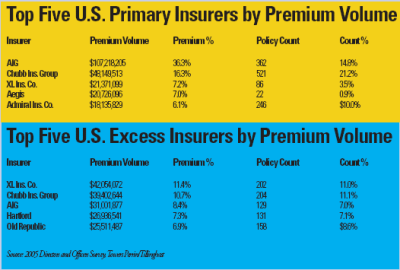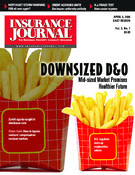Directors and officers liability insurance average premium continued to decline in 2005, dropping by 9 percent last year after a 10 percent decline in 2004, according to the “D&O Liability 2005 Survey on Claims and Insurance Purchasing Trends” conducted by the Tillinghast business of Towers Perrin.
“Premiums overall have been going down the last couple of years although at a decreasing rate,” said Elissa Sirovatka, principal of Tillinghast.
Sirovatka describes it as the classic insurance market cycle. “After WorldCom and Enron in 2001 you saw insurers react and increase premiums in 2002 and 2003,” she said. Then new capacity entered the marketplace in response to increasing premiums. “That started forcing down premiums again and I think (now) we’re hitting kind of the bottom end of the cycle, and may see things flatten out next year, and maybe even turn a little upward toward the end of this year.”
What’s surprising, Sirovatka says, is that while premiums have fallen, policy limits are on the rise.
The average policy limit increased by slightly more than $1 million from 2004 to 2005 among survey participants to $14.3 million in 2005 up from $13.6 million in 2004. However, 82 percent of respondents reported experiencing no change in policy limits during their last renewal.
“What that says is that the increase was so large … those who did increase their limits took significant increases,” Sirovatka said. “What’s significant to me is that it’s happening in a time where we are not seeing rates increase. … Rates are not going up but limits are going up.”
The study showed that the median premium index reached the lowest point since 2001, while the average premium index has decreased 18 percent from its high of 1,237 in 2003. However, claim susceptibility (the percentage of participants that reported one or more claims), frequency (the average number of claims per participant) and severity continue to rise, much as they did in 2004.
“It’s surprising that premiums have continued to decline while all other factors driving insurers’ D&O costs are on the rise,” said Jim Swanke, managing principal for the Strategic Risk Financing Practice. “We see a need for more appropriate pricing of these risks.”
Tillinghast’s survey, which included 2,694 participants, is the 28th in a series of studies on D&O liability claims and insurance purchasing trends.
Who’s buying what and why?
Sirovatka suspects that companies and their directors may be upping their D&O limits simply because the market is willing to give them more limits for cheap.
“On the other side,” she adds, “there could be some pressure from board members to increase limits to make them more comfortable.” The buying trends of companies purchasing D&O coverage maybe be changing partly because more companies today receive inquiries from board members about their D&O liability.
According to the study’s results, about 50 percent of public and private companies receive inquiries about D&O coverage from board members, while 30 percent of nonprofit companies reported receiving such inquiries. The news surrounding the highly-publicized settlements of WorldCom and Enron, where directors were forced to take money out of their own personal assets to contribute to the settlement, has prompted today’s directors to ask, “What is my D&O coverage?” Sirovatka said.
“If you talk to brokers they are seeing that boards are asking more questions,” she said. Sirovatka says that such inquiries could result in a lot of changes to individual policies. “And if there’s a great demand from board members as a whole there could be some changes in coverage as a practice,” she said.
About 19 percent of public companies that responded to the Tillinghast D&O survey made changes as a result of inquiries from board members, while just 5 percent of private and 2 percent of nonprofit respondents made changes. “The board members are in a very powerful position,” Sirovatka added.
Sirovatka said that there’s also been an increase in Side A coverage. “There may be some companies that are really just building up the limits on Side A as opposed to Side B and C,” she said.
Most respondents do purchase D&O coverage, the survey revealed. Less than 1 percent of U.S. participants responding to the Tillinghast survey did not purchase D&O liability coverage in 2005, a percentage that has stabilized over the years, Sirovatka says. The most common reason given for why companies did not purchase the coverage was that they didn’t recognize a need for it or they felt the coverage cost more than it was worth. Sirovatka says that D&O coverage has become a very prevalent coverage in the United States, and is becoming a natural course of business.
Capacity levels off
According to the survey, capacity leveled off in 2005, while coverage restrictions continued to ease. Consistent with 2004, D&O insurance carriers provided approximately $1.5 billion in full limits capacity during 2005. By the end of 2006, premium decreases are expected to flatten, and the amount of D&O coverage insurers write will start to decline, Sirovatka said.
Similar to 2004, competition remains fierce in excess layers for large public companies, where premiums for repeat participants dropped 10 percent in the excess layer and 8 percent in the primary layer. For repeat survey participants, the increase in average total policy limits was 9 percent, while the increase in average primary limits and average excess limits for this group was 2 percent and 11 percent, respectively, between 2004 and 2005.
“Not surprisingly, the largest increase in limits was in the excess layer,” said Michael Turk, senior consultant.
“It’s not as typical for a company to change their primary limits,” Sirovatka added. “If they are going to change their limits it’s going to be on the excess side.”
“However, premium decreases of a similar magnitude were reported in both the primary and excess layers,” Turk said. “Given the increase in excess limits and increasing claim severity, it seems counterintuitive that there is a decrease in the excess layer premium.”
Sirovatka explains that the market is responding to the fact that there haven’t been many big media D&O claims recently. “Insurers kind of have a short-term memory,” she said. “D&O is a very high severity low frequency line, so you’re going to see spikes up and down,” she said. But the Enron and WorldComs of the world didn’t keep insurers from lowering premiums for long. “They’re still giving away coverage and charging less … that will level off over the next year,” she said. But until something else comes along to kind of “shock the market” a little bit, not much else is expected to change, she says.
The most significant soft market conditions were observed in the government and other nonprofits business class, followed by merchandising, technology, and transportation and communication classes, according to the study. Decreases are primarily driven by declining excess premiums, according to Tillinghast. Some pockets of hard market conditions remain, notably in durable goods, education, health services and non-banking financial services (e.g., insurance carriers and investment banking).
The HealthSouth case has definitely influenced rates in the health services industry, Sirovatka said. “In the non-banking financial services arena we’ve seen things going on with investment banking that may be driving that as well,” she said. “Education is a risk that is going to have less to do with class action claims and more with employment practices liability claims,” she said. “It’s been a soft market but it’s not as soft as it was.”
Topics Trends Carriers Claims Excess Surplus Pricing Trends Market
Was this article valuable?
Here are more articles you may enjoy.



 Progressive Gains as Drivers Shop Around for Auto Insurance—Again
Progressive Gains as Drivers Shop Around for Auto Insurance—Again  Investment Funds File New Suits Over Lighthouse Insurance Collapse in 2022
Investment Funds File New Suits Over Lighthouse Insurance Collapse in 2022  Marsh McLennan Agency to Buy Fisher Brown Bottrell for About $316M
Marsh McLennan Agency to Buy Fisher Brown Bottrell for About $316M  4,800 Claims Handled by Unlicensed Adjusters in Florida After Irma, Lawsuit Says
4,800 Claims Handled by Unlicensed Adjusters in Florida After Irma, Lawsuit Says 



